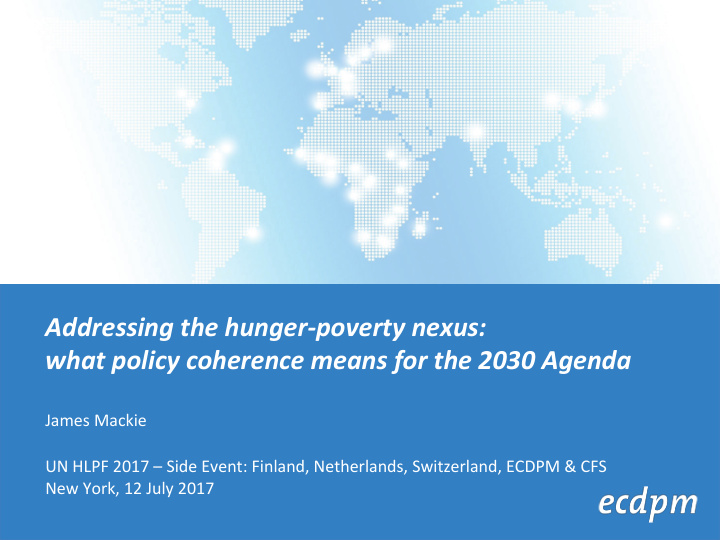



Addressing the hunger-poverty nexus: what policy coherence means for the 2030 Agenda James Mackie UN HLPF 2017 – Side Event: Finland, Netherlands, Switzerland, ECDPM & CFS New York, 12 July 2017
Outline 1. Objec.ves of research* 2. Approaches to integrated policy making 3. PCSD can learn from these different approaches 4. Lessons from PCD experience 5. Recommenda.ons *ECDPM, Discussion Paper 210 , Policy coherence & the 2030 Agenda, March 2017, www.ecdpm.org/dp210
1. Objec.ves of research Challenge of the 2030 Agenda Concept of Policy Coherence for Sustainable Development (PCSD) • Key element of the SDG framework (SDG 17:14) • Past experience of integrated policy making European history of promoVng Policy Coherence • Focus has been on Policy Coherence for Development (PCD) • ThemaVc approach has been most producVve • Two ques.ons How does PCSD differ from PCD? • Can we build on past experience for working with PCSD? •
2. Approaches to integrated policy making Iden.fied 4 different approaches 1. PCD tradi.on : Policy coherence for development Other policies should not undermine core policy / UnidirecVonal • 2. Issue-based mainstreaming Integrate specific concern in core policy / UnidirecVonal • 3. Mul.-sector approaches : Nexus approach – SDGs similar Address concerns of several sectors simultaneously / MulV- • direcVonal 4. Whole-of-government: collecVve cabinet responsibility Unified strategy to which all ministers adhere / MulV-direcVonal •
3. PCSD promoters can learn from all these Some examples • Coherence promoVon • PCD ‘champions’ or ‘policy entrepreneurs’ has worked well • Focus on a limited number of issues – Nexus + PCD • ImplemenVng authority • All 4 approaches: need for clear authority at right level: • To give leadership, and sense of direcVon • To encourage synergies and adjudicate on trade-offs • Knowledge and informaVon • Various tools useful: impact assessments, peer reviews, PCD Reports, dialogues with different actors and independent scruVny
4. Lessons from PCD experience • Policy coherence is highly poliVcal • It takes Vme and commitment PCD System – tools to make it happen • MulV-stakeholder process to build commitment • DeclaraVon of intent – policy statement to focus effort • Internal government systems to promote work across silos and encourage dialogue • Policy ‘champion’ or focal point to push concerns • Knowledge inputs: data, impact analysis, studies • Transparency and Accountability: regular reports, M&E • Debate: parliaments, stakeholders, CSOs
5. Recommenda.ons • PCSD does not replace PCD, but rather needs to build on it • PCSD: seek to combine policy coherence for different goals – needs mulVple sector champions • Make PCSD your own – poliVcal commitment is vital, look at poliVcal economy for different actors and incenVves • Build a PCSD System with interdependent parts Framework – legal/policy statements, clear locus of authority • Mechanisms – consultaVon systems, group of champions, • Knowledge systems – data, analysis, monitoring • Accountability – peer review, reporVng, independent scruVny • • Communicate on added value of PCSD – concept needs support
Thank you! jm@ecdpm.org www.ecdpm.org Paper: www.ecdpm.org/dp210 European Centre for Development Policy Management
Recommend
More recommend